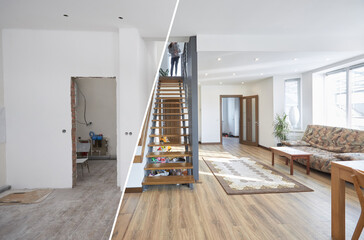
Home renovation is more than just upgrading a property—it is about enhancing comfort, functionality, and style. Over time, homes may need updates due to wear and tear, changing lifestyles, or evolving design preferences. Whether it’s modernizing a kitchen, adding an extra room, or revamping the exterior, home renovation allows homeowners to create a space that meets both aesthetic and practical needs.
The Importance of Home Renovation
Renovating a home provides several advantages that extend beyond visual appeal. It ensures that the property remains safe, functional, and efficient while reflecting the personality and lifestyle of its occupants. Renovations can prevent costly repairs, improve energy efficiency, and increase the overall value of a home.
A well-planned renovation enhances comfort, makes everyday living more enjoyable, and boosts long-term property investment. It is an opportunity to transform outdated spaces into modern, functional areas that accommodate current and future needs.
Common Home Renovation Projects
Home renovation can range from minor updates to major transformations. Some popular projects include:
- Kitchen Renovation: Upgrading cabinets, countertops, appliances, and layouts to improve efficiency and style.
- Bathroom Renovation: Installing modern fixtures, better storage, and updated flooring for enhanced comfort.
- Living Room Renovation: Improving layouts, lighting, and furnishings to create a welcoming and functional space.
- Bedroom Renovation: Adding built-in storage, updated décor, and functional designs for relaxation and productivity.
- Basement Finishing: Converting basements into living areas, offices, or entertainment spaces.
- Exterior Renovation: Updating facades, driveways, landscaping, and outdoor spaces for better curb appeal.
Each renovation project can be tailored to specific needs, allowing homeowners to prioritize comfort, style, or functionality.
Benefits of Home Renovation
Investing in home renovation offers numerous benefits:
- Increased Home Value: Modern, functional spaces appeal to buyers and enhance resale value.
- Improved Energy Efficiency: Upgrading insulation, windows, and appliances reduces utility bills.
- Enhanced Comfort: Renovations create living spaces that are more convenient and enjoyable.
- Modern Aesthetics: Updated interiors and exteriors reflect current design trends.
- Safety Improvements: Repairs and updates prevent structural issues and hazards.
- Personalization: Renovations allow homeowners to customize spaces to suit their lifestyle.
These benefits make renovation a smart choice for homeowners seeking long-term value and comfort.
Planning a Successful Home Renovation
Proper planning is critical to achieving a successful renovation. Homeowners should consider factors such as budget, design, functionality, and timeline. Creating a clear plan helps manage expectations, avoid delays, and ensure that the final results align with goals.
Key planning steps include:
- Assessing Needs: Identify areas that require updates or improvements.
- Setting a Budget: Determine costs for materials, labor, and contingencies.
- Design and Layout: Develop a plan that balances aesthetics and functionality.
- Hiring Professionals: Engage experienced contractors, designers, or specialists for quality results.
- Timeline Management: Establish realistic project schedules to minimize disruption.
A well-structured plan sets the foundation for a smooth renovation process.
Home Renovation for Modern Living
Modern homes prioritize open layouts, natural lighting, and multi-functional spaces. Renovations often focus on creating flexible areas that accommodate work, leisure, and family activities.
Integrating smart home technology is also popular in renovations, allowing homeowners to control lighting, climate, security, and entertainment systems efficiently. Energy-efficient appliances and sustainable materials further enhance comfort and reduce long-term costs.
Kitchen and Bathroom Upgrades
Kitchens and bathrooms are among the most frequently renovated areas due to their high usage and impact on daily life.
- Kitchen Renovation: Upgrading countertops, cabinets, appliances, and layouts improves cooking efficiency and creates a welcoming space for gatherings.
- Bathroom Renovation: Modern fixtures, better storage, and updated flooring enhance relaxation and functionality.
These renovations not only boost aesthetics but also provide practical benefits for homeowners.
Outdoor and Exterior Renovation
Renovation is not limited to interiors. Enhancing outdoor spaces and exteriors adds curb appeal and extends living areas. Popular outdoor upgrades include patios, decks, landscaping, and facades.
Exterior renovations protect the home from weather-related damage, improve insulation, and create attractive outdoor environments for recreation and socializing.
Choosing the Right Professionals
Professional expertise ensures that renovations are safe, high-quality, and compliant with building codes. Experienced contractors and designers bring knowledge, skill, and creative insight to every project.
Choosing reliable professionals involves considering experience, portfolio, references, and communication skills. Skilled teams help prevent costly mistakes, ensure timely completion, and achieve desired results efficiently.
Eco-Friendly Home Renovation
Sustainability is increasingly important in home renovation. Eco-friendly practices include using energy-efficient appliances, water-saving fixtures, recycled materials, and improved insulation.
Green renovations reduce environmental impact, save on utility bills, and create healthier living spaces. Homeowners benefit from combining aesthetics, comfort, and sustainability in their renovation projects.
When to Renovate
Renovation timing depends on several factors:
- Home Age: Older homes may require updates to systems, structures, and design.
- Lifestyle Changes: Expanding families or remote work needs may necessitate functional adjustments.
- Property Goals: Enhancing value or preparing for resale can prompt renovations.
- Maintenance Needs: Addressing wear, damage, or outdated systems ensures long-term durability.
Regular assessments help homeowners identify opportunities for timely and effective renovations.
Home renovation is an investment in comfort, style, and long-term property value. From updating kitchens and bathrooms to modernizing living spaces and enhancing exteriors, renovations create functional, beautiful, and sustainable environments.
With careful planning, professional guidance, and attention to detail, homeowners can transform their spaces into modern, enjoyable, and personalized areas. Whether driven by aesthetic goals, functionality, or property value, home renovation provides lasting benefits that enrich everyday living and future-proof homes for years to come.
A thoughtfully executed renovation not only revitalizes a property but also improves the overall quality of life for its occupants.
